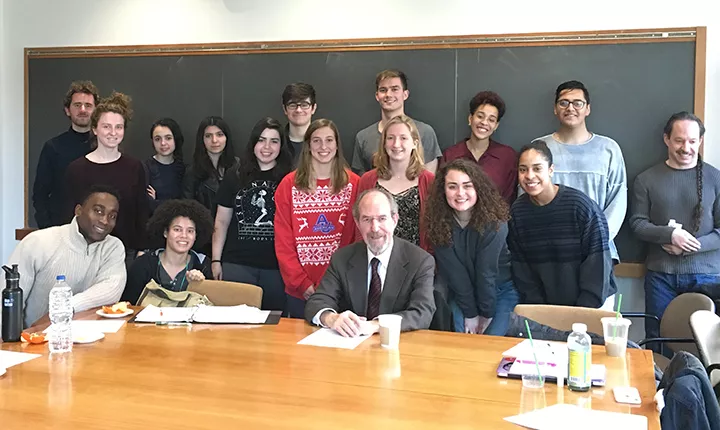Parrots and Pandemics: The Infectious Enthusiasm of Bennett Lorber '64

Dr. Bennett Lorber '64 spoke about the investigative processes and emotional connections necessary to study and treat diseases.
In the 2011 film Contagion, the outbreak of a novel virus spreads rapidly and leads to a global pandemic with 26 million deaths in a little over a month.
Could an event like that really happen today?
That question was on the minds of students in Professor Kathleen Howard’s Chemistry 003 seminar, who were paid a visit by Bennett Lorber ‘64, renowned infectious disease expert and international authority on human listeriosis.
Lorber answered that of all the movies about global pandemics he had seen, Contagion was the most realistic. Although it is very unlikely that a vaccine would be developed and distributed as fast as it was in the film, he believes that current methods of isolating breakouts and assessing their causes would render such a pandemic unlikely.
In addition to preventing the outbreak itself, students were also interested in addressing the resulting mass hysteria and moral breakdown observed in the film. Lorber revealed that Kate Winslet's character was based on fellow Swarthmore graduate and honorary degree recipient Anne Schuchat ‘80, the acting director of the Center for Disease Control and Prevention and cited how she demonstrated her masterful communication skills with the public during the Anthrax attacks, SARS outbreak, and 2009 Bird Flu pandemic.
He also offered his thoughts on the specific demands of his position. In trying to make a diagnosis or solve a public health issue, a specialist in the field has to ask deep questions that cover a wide range of human activities, such as a patient’s travel history, hobbies, sexual history, and more.
“To be an infectious disease doctor is to be in the purest form of investigative work,” Lorber says.
To illustrate, he recounted the story of a patient who was being treated for pneumonia. The patient showed all the symptoms of the infection, but staff at the hospital were perplexed to find that treatment did nothing to relieve him. Upon entering the room and spending only a few minutes with the patient, Lorber realized exactly what the disease was and told the hospital staff to test for psittacosis immediately.
Psittacosis, also known as parrot fever, is a rare infectious disease that is contracted by handling infected birds for extended periods of time. The patient’s test results came back positive, and he was given a new treatment that had him cured within days. Lorber was only able to make a quick and effective diagnosis because he noticed a small picture of the patient and his pet parrot at the bedside.
Truly, Lorber’s story brigns new meaning to the phrase: “The devil is in the details.”



